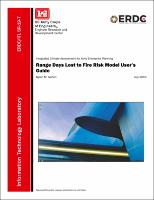Please use this identifier to cite or link to this item:
https://hdl.handle.net/11681/33555Full metadata record
| DC Field | Value | Language |
|---|---|---|
| dc.contributor.author | Garton, Byron M. | - |
| dc.date.accessioned | 2019-07-29T15:03:44Z | - |
| dc.date.available | 2019-07-29T15:03:44Z | - |
| dc.date.issued | 2019-07 | - |
| dc.identifier.govdoc | ERDC/ITL SR-19-7 | - |
| dc.identifier.uri | https://hdl.handle.net/11681/33555 | - |
| dc.identifier.uri | http://dx.doi.org/10.21079/11681/33555 | - |
| dc.description | Special Report | - |
| dc.description.abstract | Maintaining and increasing the capacity to perform live fire training exercises on Department of Defense (DoD) lands is essential to future force readiness and effectiveness. The risk of fire on ranges as a potential result of climate change is one factor affecting the availability of training areas. Assessing the impact of future climate change is an essential part of ensuring future availability of live fire ranges. This document describes the process of executing the Range Days Lost to Fire Risk Model, as it exists at the time of this writing, within the common computational environment established under the software integration effort of the Integrated Climate Assessment for Army Enterprise Planning work package. | en_US |
| dc.description.sponsorship | Integrated Climate Assessment for Army Enterprise Planning Program (U.S.) | en_US |
| dc.description.tableofcontents | Abstract ................................................................................................................................................... ii Figures and Tables ................................................................................................................................. iv Preface ..................................................................................................................................................... v 1 Introduction ..................................................................................................................................... 1 2 Viewing Computed Data ................................................................................................................ 3 3 Building New Data .......................................................................................................................... 8 4 Known Issues and Limitations .................................................................................................... 11 5 Additional Help ............................................................................................................................. 12 References ............................................................................................................................................ 13 Appendix A: Acronyms and Abbreviations ........................................................................................ 14 Report Documentation Page | - |
| dc.format.extent | 22 pages / 1.571 Mb | - |
| dc.format.medium | - | |
| dc.language.iso | en_US | en_US |
| dc.publisher | Information Technology Laboratory (U.S.) | en_US |
| dc.publisher | Engineer Research and Development Center (U.S.) | - |
| dc.relation.ispartofseries | Special Report (Engineer Research and Development Center (U.S.)) ; no. ERDC/ITL SR-19-7 | - |
| dc.rights | Approved for Public Release; Distribution is Unlimited | - |
| dc.source | This Digital Resource was created in Microsoft Word and Adobe Acrobat | - |
| dc.subject | Military bases | en_US |
| dc.subject | Bombing and gunnery ranges | en_US |
| dc.subject | Rifle-ranges | en_US |
| dc.subject | Fire risk assessment | en_US |
| dc.subject | Climatic changes--Risk assessment | en_US |
| dc.title | Range Days Lost to Fire Risk Model user’s guide | en_US |
| dc.type | Report | en_US |
| Appears in Collections: | Special Report | |
Files in This Item:
| File | Description | Size | Format | |
|---|---|---|---|---|
| ERDC-ITL SR-19-7.pdf | 1.61 MB | Adobe PDF |  View/Open |